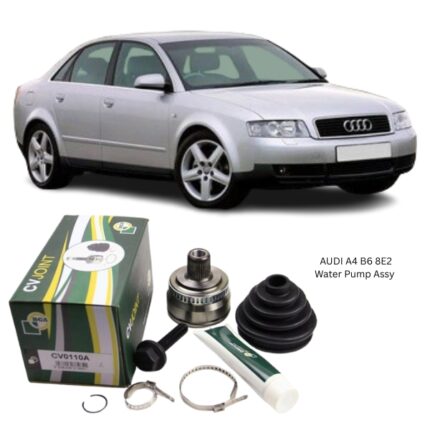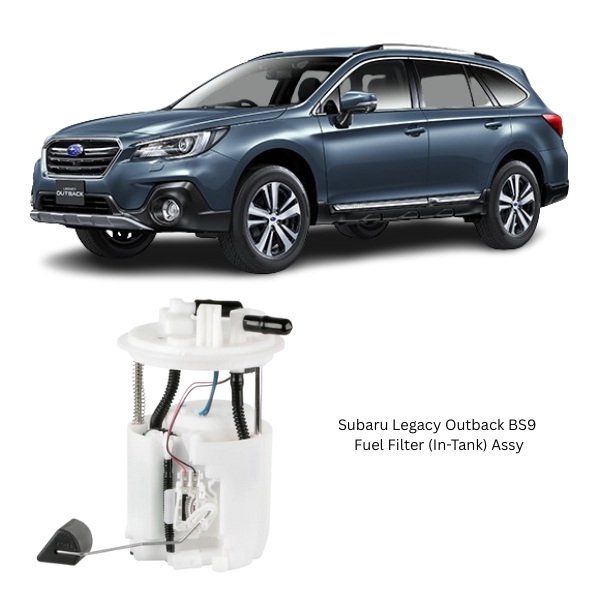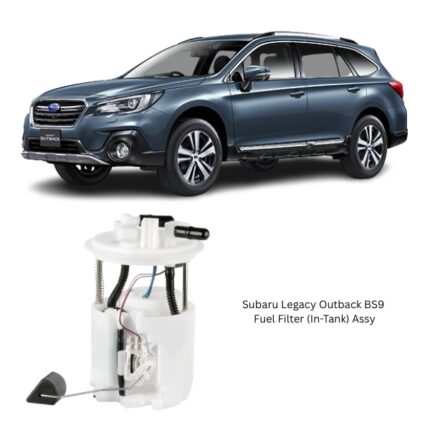Get Subaru Legacy Outback BS9 Fuel Filter (In-Tank) Assy 42021-SG000 in Kenya
The Fuel Filter (In-Tank) Assembly is a critical component of a vehicle’s fuel delivery system, specifically designed to remove contaminants from the fuel before it reaches the engine. Located inside the fuel tank, this assembly ensures that only clean, high-quality fuel is delivered to the injectors, promoting efficient combustion, protecting engine components, and maintaining optimal performance.
Unlike traditional inline fuel filters mounted along the fuel line, the in-tank design integrates the filtration system directly with the fuel pump module, providing both filtration and efficient fuel pickup in a compact unit.
Purpose and Function
The purpose of the in-tank fuel filter assembly is twofold:
-
Filtration – Remove dirt, rust particles, sediment, and other impurities that can be present in the fuel, whether introduced during refueling or formed by corrosion inside the tank.
-
Fuel System Protection – Safeguard sensitive engine components, especially fuel injectors, from abrasive wear, clogging, or malfunction due to contaminated fuel.
By performing these functions, the in-tank fuel filter helps:
-
Maintain smooth fuel flow.
-
Ensure precise fuel atomization in the combustion chamber.
-
Prevent misfires, reduced power output, and engine stalling.
-
Extend the life of the fuel pump and injectors.
Construction and Components
The Fuel Filter (In-Tank) Assembly is typically part of the fuel pump module and includes the following elements:
-
Filter Housing – A durable, fuel-resistant casing that encases the filter element and protects it from direct contact with the tank’s contents.
-
Filter Media – The heart of the assembly, usually made of high-grade synthetic fibers, cellulose, or multi-layer mesh designed to trap particles as small as a few microns without restricting flow.
-
Fuel Pump Strainer (Pre-Filter) – A fine mesh screen that serves as the first stage of filtration, removing larger particles before fuel enters the main filter element.
-
Fuel Pump Mounting Points – Connection points that secure the assembly within the tank while allowing easy access for replacement.
-
Seals and Gaskets – High-quality rubber or Viton components that prevent leaks and maintain fuel system pressure.
-
Outlet Port – Connects to the fuel line, delivering clean, filtered fuel to the engine.
Filtration Process
The filtration process occurs in two stages:
-
Pre-Filtration – As the fuel pump draws fuel from the tank, it passes through the pump strainer. This removes large debris such as rust flakes or dirt particles.
-
Main Filtration – The fuel then enters the primary filter media, where microscopic particles, varnish deposits, and fine contaminants are trapped.
Clean fuel exits the filter assembly and travels under pressure through the fuel lines to the injectors. This two-stage process ensures maximum protection for the entire fuel system.
Advantages of an In-Tank Design
Compared to externally mounted fuel filters, the in-tank design offers several benefits:
-
Compact Integration – Combines pump and filter in one unit, saving space and simplifying assembly.
-
Enhanced Contaminant Control – Filters fuel at the source, reducing the risk of debris entering downstream components.
-
Improved Pump Longevity – Clean fuel lubricates and cools the pump, extending its service life.
-
Reduced Risk of Leaks – Fewer external connections mean fewer potential leak points.
-
Lower Noise – The tank location insulates pump noise for quieter operation.
Importance of Filtration Quality
Modern fuel injection systems operate at very high pressures and rely on extremely fine injector nozzles to atomize fuel properly. Even particles smaller than a human hair can disrupt this process. A high-quality in-tank fuel filter assembly:
-
Traps particles as small as 5–10 microns.
-
Maintains a consistent flow rate under varying fuel demands.
-
Resists degradation from ethanol blends and other additives found in modern fuels.
Signs of Wear or Clogging
Over time, the filter media can become saturated with debris, restricting fuel flow. Common symptoms of a clogged in-tank fuel filter include:
-
Difficulty starting the engine.
-
Reduced acceleration or power loss under load.
-
Rough idling or hesitation.
-
Frequent stalling, especially during uphill driving.
-
Unusual whining noise from the fuel pump.
If left unchecked, a clogged filter forces the fuel pump to work harder, potentially leading to premature pump failure.
Maintenance and Replacement
While in-tank fuel filters are designed to last longer than older inline filters, they are not lifetime components. Replacement intervals vary depending on driving conditions, fuel quality, and manufacturer specifications, but typical guidelines include:
-
Every 80,000 to 160,000 km (50,000 to 100,000 miles) for most vehicles.
-
More frequent replacement if contaminated fuel is suspected.
Maintenance Tips:
-
Use clean, reputable fuel sources to reduce contamination risk.
-
Avoid running the tank too low, as sediment tends to collect at the bottom.
-
Replace the entire pump and filter assembly if severe clogging or pump failure occurs.
Installation Considerations
Replacing an in-tank fuel filter assembly requires careful handling due to fuel’s flammability and the location inside the tank:
-
Depressurize the fuel system before removal.
-
Disconnect the battery to prevent sparks.
-
Ensure proper sealing of the assembly to avoid fuel leaks or pressure loss.
-
Use only the correct RH or LH orientation if applicable to multi-tank or dual-pump systems.
Performance Specifications
A well-designed in-tank fuel filter assembly should:
-
Provide filtration efficiency of 98% or higher for particles in the 5–10 micron range.
-
Maintain consistent flow rates matching the fuel pump’s output capacity.
-
Withstand continuous exposure to fuel, including ethanol blends, without degradation.
-
Resist pressure drop under peak demand conditions.
-
Operate reliably in a wide temperature range, from extreme cold starts to high-heat conditions inside the tank.
Impact on Engine Performance
The condition of the in-tank fuel filter has a direct effect on:
-
Fuel Delivery Accuracy – Ensuring injectors receive a steady, clean supply of fuel.
-
Combustion Efficiency – Supporting complete and balanced combustion, improving fuel economy and reducing emissions.
-
Engine Longevity – Preventing premature wear on injectors, valves, and pistons caused by abrasive particles.
-
Cold-Start Reliability – Providing unobstructed fuel flow even in cold conditions when fuel is denser.
Environmental and Safety Considerations
Fuel filters trap not only particles but also residues from degraded fuel. Proper disposal of used assemblies is essential to prevent environmental contamination. Recycling programs allow recovery of metal components while ensuring safe disposal of fuel-soaked filter media.
Follow Us On Facebook For More Parts.





Reviews
Clear filtersThere are no reviews yet.